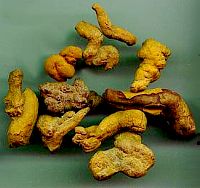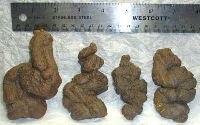

 COPROLITES
COPROLITES
(Dinosaur Poop)
 Coprolites are the fossilized contents of the intestine and the excrement of organisms; in other words, fossilized feces. They feel like pieces of rock, but look like ... well, poop!
Coprolites are the fossilized contents of the intestine and the excrement of organisms; in other words, fossilized feces. They feel like pieces of rock, but look like ... well, poop!
|
 Coprolites of fish and reptiles are especially common. Those of dinosaurs are quite rare, partly because they are often overlooked, but mostly because excrement decays quickly and doesn't sit around long enough for some event (usually burial in mud) to cause its fossilization.The picture at the left is the fossilized feces from a hadrosaur of the Creataceous period. Analysis of dinosaur poop will increase our understanding of dinosaur diets, information that is unavailable from skeletal fossils.
Coprolites of fish and reptiles are especially common. Those of dinosaurs are quite rare, partly because they are often overlooked, but mostly because excrement decays quickly and doesn't sit around long enough for some event (usually burial in mud) to cause its fossilization.The picture at the left is the fossilized feces from a hadrosaur of the Creataceous period. Analysis of dinosaur poop will increase our understanding of dinosaur diets, information that is unavailable from skeletal fossils.
 The coprolite at the right is probably from a sauropod, because of its large size (40 cm diameter), and age (Jurassic); a coprolite this large probably does not represent one single pellet but a conglomeration of several pellets that merged. Individual dinosaur coprolites actually can be quite small (under 10 cm length) compared to the body size of the creatures. An example of this can be observed in modern mule deer and elk, animals that can weigh much more than 100 kg but leave many individual pellets less than 1 cm in diameter.
The coprolite at the right is probably from a sauropod, because of its large size (40 cm diameter), and age (Jurassic); a coprolite this large probably does not represent one single pellet but a conglomeration of several pellets that merged. Individual dinosaur coprolites actually can be quite small (under 10 cm length) compared to the body size of the creatures. An example of this can be observed in modern mule deer and elk, animals that can weigh much more than 100 kg but leave many individual pellets less than 1 cm in diameter.
EXAMINE A COPROLITE:
O.K., not a real one. But you can discover for yourself what can be learned from animal waste, if you can obtain a sample from outdoors, of rabbit, deer, moose, or bear feces. Using a magnifying glass and a sharp knife (and some rubber gloves!) examine the inside of your sample. Can you can tell what kind of things the creature ate? You might find bits of vegetable matter, seeds, or insect parts. A much more revealing sample would be owl pellets, if you can find any. Not feces, these little packets are what the owl regurgitates after digesting a meal; you can find mouse fur and bones, and other easily identifiable bits of undigestable prey!

Coprolites can contain plant material (indicating an herbivorous diet) or bones (indicating a carnivorous diet). Modern grizzly bears, on the other hand, will leave feces containing both plant and animal matter (indicating an omnivorous diet), but apparently no dinosaur coprolites have been found that demonstrate this.
The coprolites pictured at the right are from the Eocene, 60 million years ago, and likely come from turtle or alligator-like creatures.
 Coprolites made by carnivorous dinosaurs were more likely to be preserved than those made by herbivores because of the high mineral content in the bones of the consumed prey animals. A good preservational environment would have been floodplains near rivers, where the feces deposited on a dry part of the floodplain dehydrated slightly before rapid burial by a river flood.
Coprolites made by carnivorous dinosaurs were more likely to be preserved than those made by herbivores because of the high mineral content in the bones of the consumed prey animals. A good preservational environment would have been floodplains near rivers, where the feces deposited on a dry part of the floodplain dehydrated slightly before rapid burial by a river flood.
Other environments where coprolites were likely to have been preserved include watering holes, swamps, streams, and muddy areas. Sediments containing the coprolites (and other fossils) were buried under layers of ground, and subjected to pressure; eventually the organic material leached out and was replaced by minerals, and a fossil was formed!
Timothy Tokaryk, a paleontologist at the Royal Saskatchewan Museum in Eastend, Saskatchewan, has found what he figures is probably a coprolite from Tyrannosaurus Rex. The coprolite's size (about 44 cm) and high bone content suggests it came from the bowels of a very large carnivore. T. rex is the most likely source . This coprolite could help answer an old question ... whether T. rex and other carnivorous dinosaurs chewed their food, or devoured it whole like modern crocodiles and digested the bones for nutrients. Up to half of this newly discovered coprolite is bone, crunched but not digested, suggesting T. rex was a chewer; the bone fragments indicate T. rex might have ripped its prey into small pieces before eating, and that it devoured young herbivores. But more examples are needed before too many conclusions can be drawn.
Find out what colour dinosaurs really were.
|
 Dr. Deadly's Science Lab Question Dr. Deadly's Science Lab Question
"Why is it difficult to identify which dinosaur could have been responsible for a particular coprolite that has been unearthed?"
Scroll way down to check your answer.
There were many similar dinosaurs with similar diets.
|
Science Lab | Resources
|